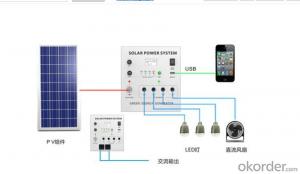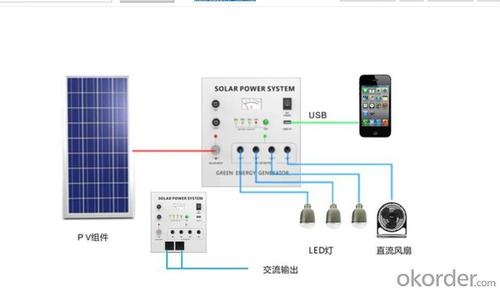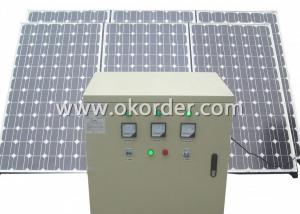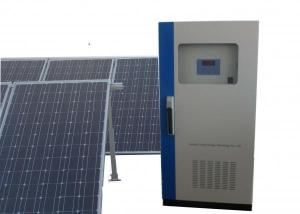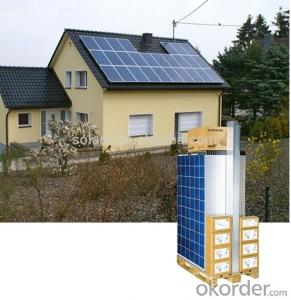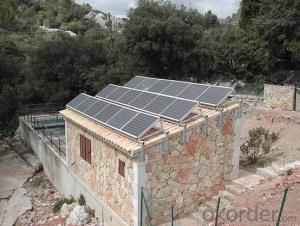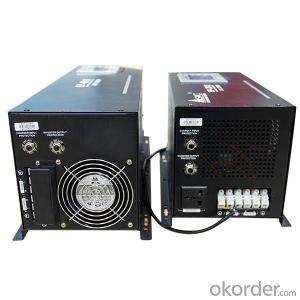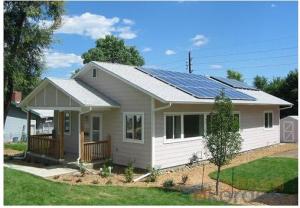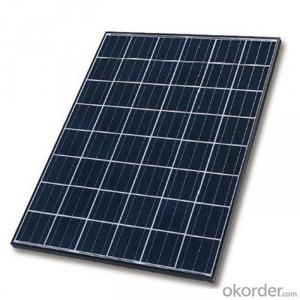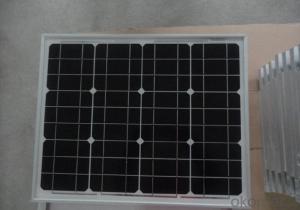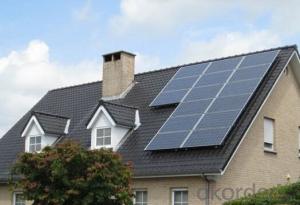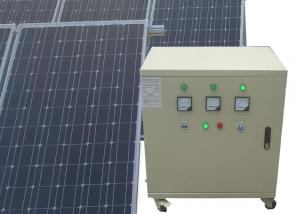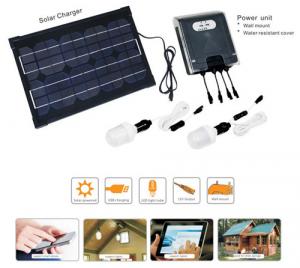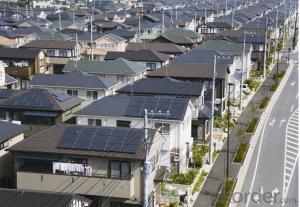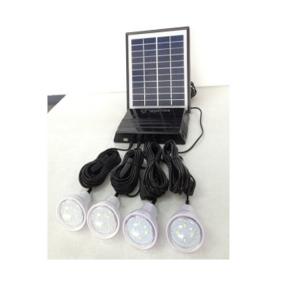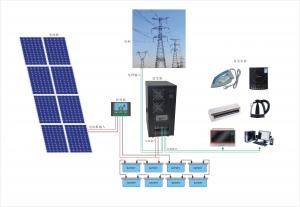Red Sun Solar Energy Systems - Solar System 30W Made in China
- Loading Port:
- China Main Port
- Payment Terms:
- TT OR LC
- Min Order Qty:
- -
- Supply Capability:
- -
OKorder Service Pledge
Quality Product, Order Online Tracking, Timely Delivery
OKorder Financial Service
Credit Rating, Credit Services, Credit Purchasing
You Might Also Like
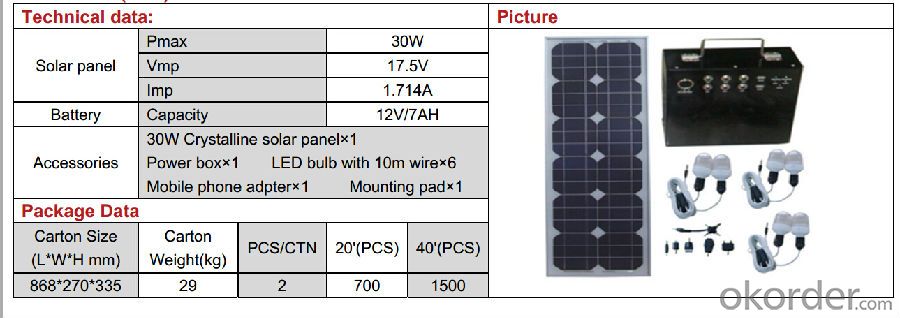
- Q: Can solar energy systems be used in areas with limited space for ground-mounted installations?
- Yes, solar energy systems can still be used in areas with limited space for ground-mounted installations. In such cases, alternative mounting options can be utilized, such as roof-mounted solar panels or vertical solar panel installations. Roof-mounted solar panels are a popular solution for homes and buildings with limited ground space, as they utilize the available roof area to capture sunlight and convert it into electricity. Additionally, vertical solar panel installations, where solar panels are mounted vertically on walls or other structures, can also be implemented in areas where ground space is limited. These vertical installations allow for solar energy generation in tight spaces or even on building facades. Therefore, even in areas with limited space for ground-mounted installations, solar energy systems can still be effectively utilized through alternative mounting options.
- Q: How long do solar energy systems last?
- Solar energy systems typically have a lifespan of 25 to 30 years, although some components may need to be replaced or upgraded during that time.
- Q: Can a solar energy system be integrated with an existing electrical system?
- Integrating a solar energy system with an existing electrical system is indeed possible. Many people choose to install solar panels on their homes or businesses and connect them to their current electrical systems. This connection involves the installation of an inverter, which converts the solar panels' DC power into AC power, suitable for powering appliances and devices. The inverter is then linked to the existing electrical system, allowing the solar energy system to supplement or even replace grid electricity. By integrating solar energy, one can efficiently and sustainably utilize solar power while still having access to grid electricity when necessary. This integration also allows for net metering, wherein excess solar electricity can be sent back to the grid for credit or compensation. Proper planning and installation of a solar energy system with an existing electrical system can significantly reduce energy costs, decrease reliance on fossil fuels, and contribute to a cleaner and more sustainable energy future.
- Q: Can solar energy systems be used for powering wastewater or sewage treatment plants?
- Wastewater or sewage treatment plants can indeed utilize solar energy systems. Solar panels or solar thermal systems can be employed to harness solar energy, generating electricity or heat to power various processes in these treatment plants. To generate electricity, solar panels convert sunlight into usable energy through photovoltaic cells. These panels can be installed either on rooftops or open fields near the treatment plants. The electricity produced can then be utilized to power pumps, blowers, and other necessary equipment in the treatment process. By adopting solar energy, these plants can significantly reduce their dependence on traditional grid electricity, resulting in cost savings and a diminished carbon footprint. On the other hand, solar thermal systems utilize the sun's heat to generate hot water or steam. This heat can be effectively used in the treatment process, particularly for heating water or sludge. Integrating solar thermal systems into the existing infrastructure of treatment plants provides a sustainable and renewable source of thermal energy. In addition to cost-effectiveness and environmental benefits, solar energy systems offer the advantage of decentralization and independence from the grid. As a result, even in remote areas or during power outages, wastewater or sewage treatment plants can continue to operate efficiently. Overall, employing solar energy systems to power wastewater or sewage treatment plants is a feasible and sustainable approach that contributes to a cleaner and more energy-efficient water management system.
- Q: How does the efficiency of solar panels vary based on the cleanliness?
- The cleanliness of solar panels can impact their efficiency. When solar panels are free from dirt, dust, or debris, they are able to capture more sunlight and convert it into electricity more effectively. Clean solar panels are less likely to be obstructed by dust particles, which can limit their ability to absorb sunlight. Furthermore, a buildup of dirt or grime on the surface of solar panels can create a barrier that blocks sunlight from reaching the photovoltaic cells, thus reducing their efficiency. To ensure optimal performance, it is crucial to regularly clean and maintain solar panels. By keeping them clean, their efficiency can be maximized, resulting in improved electricity generation. It is advisable to periodically clean solar panels, especially in areas with high levels of dust or pollution, or during seasons when there is an increased presence of pollen or debris in the air. By doing so, the solar panels can continue to operate at their highest efficiency, leading to increased energy production and overall system performance.
- Q: Can a solar energy system be installed on a historic building?
- Installing a solar energy system on a historic building is indeed possible, but it necessitates careful consideration and planning to avoid compromising the building's integrity or aesthetic appeal. Preservation laws and regulations often safeguard historic buildings, which can impose limitations on visible modifications. In such instances, solar panels can be strategically placed on the less conspicuous sides or at the rear of the building, or even incorporated into existing structures like roofs or awnings to minimize their visual impact. Collaboration with preservation experts and architects is essential in designing the solar system to ensure it harmonizes with the building's historic character. By undertaking proper planning and execution, a solar energy system can successfully blend into a historic building, simultaneously reducing its carbon footprint and preserving its architectural charm.
- Q: Can a solar energy system be used in areas with high levels of dust or sand?
- Yes, a solar energy system can be used in areas with high levels of dust or sand. However, it is important to note that excessive dust or sand accumulation can reduce the efficiency of the system over time. To mitigate this, regular maintenance and cleaning of the solar panels may be required. Additionally, installing the panels at an angle or using anti-reflective coatings can help minimize the impact of dust or sand on the system's performance. Despite these challenges, solar energy systems can still be successful in these areas, especially if proper precautions and maintenance are taken.
- Q: How much sunlight is needed for a solar energy system to be effective?
- A solar energy system can be effective with as little as 4-5 hours of direct sunlight per day, although more sunlight will generally result in higher energy production.
- Q: What is the lifespan of solar cells used in solar energy systems?
- The lifespan of solar cells used in solar energy systems can vary, but on average, they are designed to last for approximately 25 to 30 years.
- Q: Can solar energy systems be used in areas with high levels of saltwater exposure?
- Yes, solar energy systems can be used in areas with high levels of saltwater exposure. However, special considerations and precautions need to be taken to protect the solar panels and related equipment from the corrosive effects of saltwater. This can include using corrosion-resistant materials, regular cleaning and maintenance, and implementing protective measures such as barriers or enclosures.
Send your message to us
Red Sun Solar Energy Systems - Solar System 30W Made in China
- Loading Port:
- China Main Port
- Payment Terms:
- TT OR LC
- Min Order Qty:
- -
- Supply Capability:
- -
OKorder Service Pledge
Quality Product, Order Online Tracking, Timely Delivery
OKorder Financial Service
Credit Rating, Credit Services, Credit Purchasing
Similar products
Hot products
Hot Searches
Related keywords
